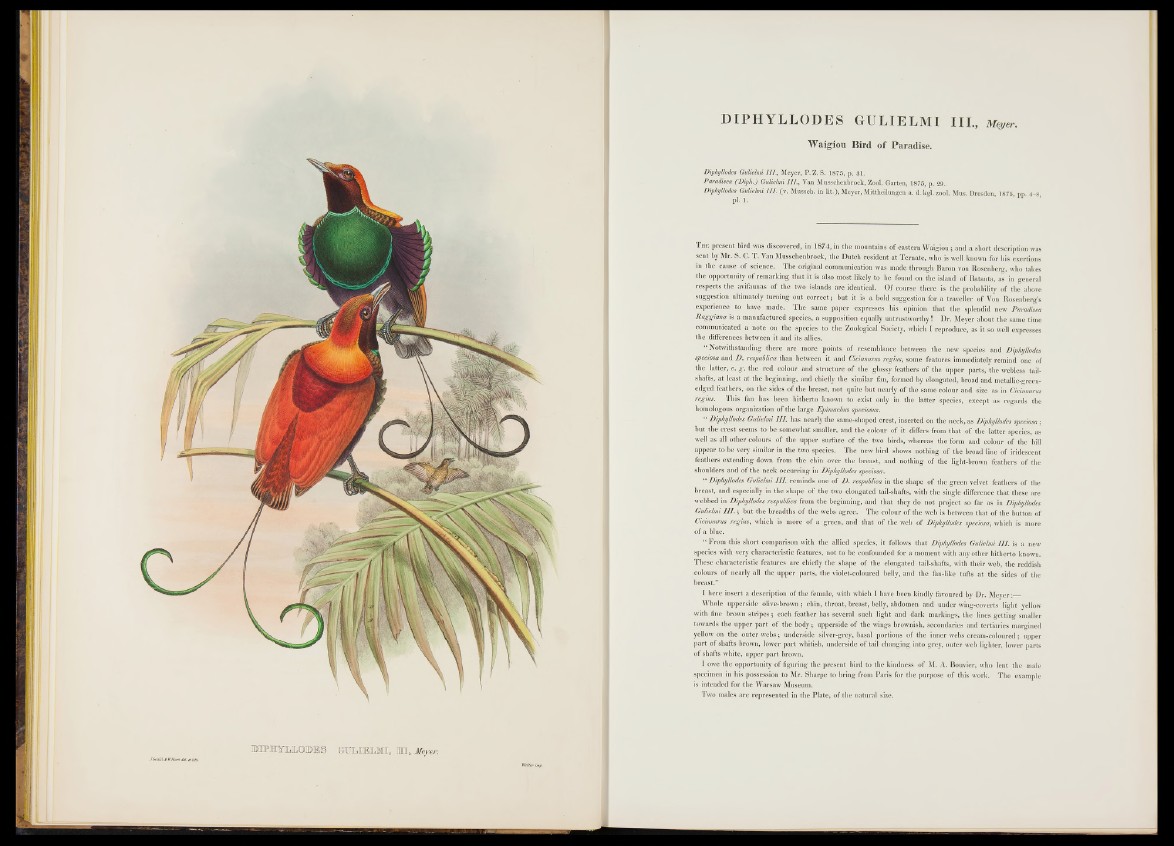
BEOTHLLOIMES GTOLBE1MI» IH, Meyer.
DIPHYLLODES GULIELMI III., Meyer.
Waigiou Bird of Paradise.
Diphyllodes Guliebni III., Meyer, P. Z. S. 1875, p. 31.
Paradisea ( Diph.) Guliebni III., Van Musschenbroek, Zool. Garten, 1875, p. 29.
Diphyllodes Guliebni III. (v. Mussch. in lit.), Meyer, Mittheilungen a. d. kgl. zool. Mus. Dresden 1875 pp 4-8
pl. 1,
The present bird was discovered, in 1874, in the mountains o f eastern Waigiou; and a short description was
sent by Mr. S. C. T. Van Musschenbroek, the Dutch resident at Ternate, who is well known for his exertions
in the cause o f science. The original communication was made through Baron von Rosenberg, who takes
the opportunity o f remarking that it is also most likely to he found on the island o f Batanta, as in general
respects the avifaunas of the two islands are identical. Of course there is the probability of the above
suggestion ultimately turning out correct; but it is a bold suggestion for a traveller o f Von Rosenberg’s
experience to have made. The same paper expresses his opinion that the splendid new Paradisea
Raggiana is a manufactured species, a supposition equally untrustworthy! Dr. Meyer about the same time
communicated a note on the species to the Zoological Society, which I reproduce, as it so well expresses
the differences between it and its allies.
“ Notwithstanding there are more points o f resemblance between the new species and Diphyllodes
speciosa and D . respublica than between it and Cicinnurus regius, some features immediately remind one of
the latter, e. g . the red colour and structure of the glossy feathers o f the upper parts, the webless tail-
shafts, at least at the beginning, and chiefly the similar fan, formed by elongated, broad and metallic-green-
edged feathers, on the sides o f the breast, not quite but nearly o f the same colour and size as in Cicinnurus
regius. This fan has been hitherto known to exist only in the latter species, except as regards the
homologous organization o f the large Epimachus speciosus.
“ Diphyllodes Gulielmi I I I . has nearly the same-shaped crest, inserted on the neck, as Diphyllodes speciosa;
but the crest seems to be somewhat smaller, and the colour o f it differs from that o f the latter species, as
well as all other colours o f the upper surface o f the two birds, whereas the form and colour o f the bill
appear to be very similar in the two species. The new bird shows nothing o f the broad line o f iridescent
feathers extending down from the chin over the breast, and nothing of the light-brown feathers o f the
shoulders and o f the neck occurring in Diphyllodes speciosa.
“ Diphyllodes Gulielmi I I I . reminds one o f D . respublica in the shape o f the green velvet feathers o f the
breast, and especially in the shape o f the two elongated tail-shafts, with the single difference that these are
webbed in Diphyllodes respublica from the beginning, and that they do not project so far as in Diphyllodes
Gulielmi I I I . ; but the breadths o f the webs agree. The colour o f the web is between that of the button of
Cicinnurus regius, which is more o f a green, and that o f the web o f Diphyllodes speciosa, which is more
o f a blue.
“ From this short comparison with the allied species, it follows that Diphyllodes Gulielmi I I I . is a new
species with very characteristic features, not to be confounded for a moment with any other hitherto known.
These characteristic features are chiefly the shape o f the elongated tail-shafts, with their web, the reddish
colours o f nearly all the upper parts, the violet-coloured belly, and the fan-like tufts at the sides o f the
breast.”
I here insert a description o f the female, with which I have been kindly favoured by Dr. Meyer:—
Whole upperside olive-brown; chin, throat, breast, belly, abdomen and under wing-coverts light yellow
with fine brown stripes; each feather has several such light and dark markings, the lines getting smaller
towards the upper part of the body; upperside o f the wings brownish, secondaries and tertiaries margined
yellow on the outer webs; underside silver-grey, basal portions o f the inner webs cream-coloured; upper
part o f shafts brown, lower part whitish, underside o f tail changing into grey, outer web lighter, lower parts
o f shafts white, upper part brown.
I owe the opportunity o f figuring the present bird to the kindness o f M. A. Bouvier, who lent the male
specimen in his possession to Mr. Sharpe to bring from Paris for the purpose o f this work. The example
is intended for the Warsaw Museum.
Two males are represented in the Plate, o f the natural size.